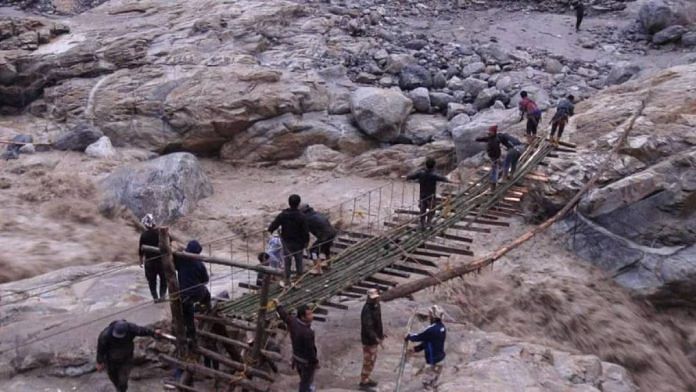New Delhi: A preliminary report of the National Dam Safety Authority (NDSA) on the “flash flood in Teesta basin” in Sikkim has said dam authorities lost crucial time in taking preparatory action, such as opening spillway gates and reducing water in the reservoir, after they were informed by the Indo Tibetan Border Police (ITBP) that water level in the river was rising, ThePrint has learnt.
In the intervening night of 3-4 October this year, the South Lhonak glacial lake in north Sikkim burst its banks, causing deadly floods that claimed 89 lives and extensively damaged physical infrastructure in the state, including road networks, bridges and three big hydropower projects. The flash flood washed away the Chungthang dam and damaged the spillways of Dikchu dam.
According to sources in the Sikkim government and the central government, the NDSA has said in its preliminary report that between the period the ITBP informed the dam authorities that water in the Teesta river was rising and the deluge reached Chungthang town, the dam authorities had enough time to take measures such as emptying or at least reducing water in the dam’s reservoir.
“The NDSA had said in its report that the dam authorities, instead of acting on the ITBP’s communication, lost crucial time in confirming the news. By the time the water actually reached Chungthang dam, it was too late to do anything. A team of dam staff had at the last moment gone to open the gates but was swept away,” one of the central government sources, who did not wish to be identified, told ThePrint.
A Sikkim government official, who too did not want to be named, said the reservoir of the Chungthang dam was full as the Teesta Stage-III hydropower plant was being run at 10-15 percent over capacity. The reservoir, the official added, was holding approximately 5 million cubic metre of water.
The NDSA has shared the preliminary report with the Union Jal Shakti ministry, the Sikkim government, State Dam Safety Organisations of Sikkim and West Bengal, and the Union power ministry in mid-October. A final report will be submitted in three months’ time.
ThePrint reached Sikkim chief secretary V.B. Pathak for comment on the NDSA report over phone and text messages, the article will be updated if and when he responds.
ThePrint also reached S.K. Sibal, member, Central Water Commission, who holds the additional charge of NDSA chairman over phone for comment, but did not receive a response till the time of publication of this report.
Also Read: What turned Teesta into a killer? Here’s proof Sikkim flash floods are a man-made disaster
Sikkim govt ‘did not act’ on 2015 advisory on South Lhonak Lake
According to sources, the NDSA report mentions that the Central Water Commission (CWC) had way back in 2015 issued an advisory to the Sikkim government that the South Lhonak lake was a potential threat as its size was increasing.
“The report has attached a copy of the advisory that quotes the discharge from the South Lhonak lake. The Sikkim government was also advised to take action such as installing an Early Warning System (EWS) and being in a mode of readiness to handle more discharge,” the central government official quoted earlier said.
The Sikkim government, sources said, had not taken any action on the advisory.
The NDSA states in its report that the state government had not put in place an EWS which could have sent alerts in case of a flash flood. “The report says that even if the EWS was in place somewhere, it was probably not functioning,” the Sikkim government official said.
The report looked into the state of hydropower projects on the Teesta basin and the damages they had suffered in the flash flood.
These include three of the largest projects — the state-run Sikkim Urja’s 1,200 MW Teesta Stage-III, NHPC’s 510 MW Teesta-V and an independent power producer’s 96 MW Dikchu project.
Teesta-III project’s Chungthang dam got washed away in the flood, as were the five spillways of Teesta-V’s Dikchu dam.
10-member committee to assess ground situation
The NDSA’s preliminary report is based on the interaction that its officials had with various stakeholders in the state.
A team from the NDSA had gone to Bagdogra in West Bengal on 5-6 October but could not reach Sikkim because the road network was extensively damaged in the flash flood.
The NDSA has now set up a 10-member committee, headed by former CWC chairman R.K. Jain, which will look into the ground situation and give a final report.
The committee will visit Chungthang dam as well as other dams and hydropower projects on the Teesta River basin, before submitting a final report.
(Edited by Nida Fatima Siddiqui)
Also Read: A burst glacial lake caused Sikkim flood. What’s a GLOF & why Indian subcontinent’s at great risk



